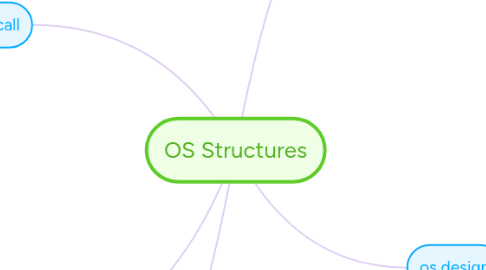
1. system call
1.1. interface between running program & OS
1.2. 3 general method
1.2.1. pass parameter in register
1.2.2. parameter stored in block
1.2.2.1. address passed as parameter
1.2.3. parameter placed/pushed onto stack
1.3. types
1.3.1. process contol
1.3.2. file management
1.3.3. device management
1.3.4. information maintenance
1.3.5. communications
1.3.6. protection
2. layered approach
2.1. each layer built on top of lower layer
2.2. advantage
2.2.1. simplicity of construction & debugging
2.3. disadvantages
2.3.1. careful definition & interaction of layers
2.3.2. less efficient
3. microkernel
3.1. small os core
3.2. advantages
3.2.1. extensibility
3.2.2. flexibility
3.2.3. reliability
3.2.4. portability
4. By the way, this is a floating topic. To create a floating topic, simply drag it away from the map center.
5. OS services
5.1. user interface
5.2. program execution
5.3. i/o operation
5.4. file-system manipulation
5.5. communication
5.5.1. shared memory
5.5.2. message passing
5.6. error detection
5.7. additional
5.7.1. resources allocation
5.7.2. accounting
5.7.3. protection & security
6. os design
6.1. goals
6.1.1. user goals
6.1.1.1. convenient
6.1.1.2. easy to learn
6.1.1.3. reliable
6.1.1.4. safe
6.1.1.5. fast
6.1.2. system goals
6.1.2.1. easy design & implementation & maintain
6.1.2.2. flexible
6.1.2.3. reliable
6.1.2.4. efficient
6.1.2.5. error-free
6.2. specification
6.2.1. choice of hardware
6.2.2. type of system

